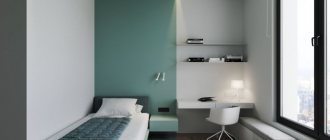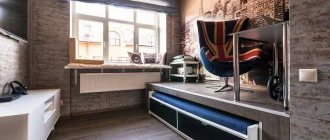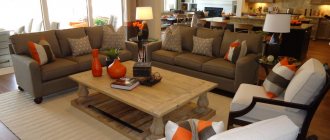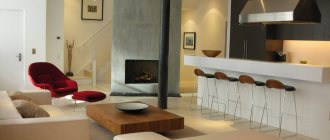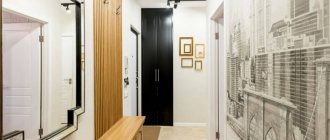Types of interior partitions
Depending on the design features, all partitions can be divided into two types:
• solid partitions; • frame-type partitions.
Solid interior partitions
Solid interior partitions can be built from gypsum concrete slabs and blocks, as well as laid out from brick (the width of such an interior partition is half a brick) or made from wooden lumber.
The design of frame-type interior partitions includes a frame, the internal space of which is filled with some kind of material (filler).
Frame-type interior partitions
The construction of frame-type interior partitions begins with the installation of the frame.
The materials used to construct the frame of such a partition are steel or aluminum profiles, profiles made of polymeric materials (in particular, PVC), and wooden beams.
To fill the frame space, sheets of plasterboard or polymer materials are used.
Plywood sheets, regular or eurolining, as well as other materials available on the market can also be used as filler.
Selection of materials for the construction of interior partitions
Gypsum concrete and brick interior partitions have significant strength, which makes it possible to further attach hanging furniture or other heavy objects to such partitions.
However, their construction and subsequent finishing require significant labor costs.
If the partition is planned to separate a room with high humidity (for example, a bathroom or shower room), then the use of materials that do not have a sufficient degree of moisture resistance is inappropriate.
So, in this case it is undesirable to use drywall.
Wooden interior partitions meet the highest environmental requirements.
Wood is easy to process and has sufficient strength, and after finishing it the entire room takes on a very attractive appearance. However, its disadvantage is low fire resistance.
Other options
To zone a room, designers often use clever tricks:
- Bar counter. Ideal for separating the kitchen from the dining room or the dining room from the living room. On one side you can put chairs, and on the other, build a shelf with a TV into a high wall. In a small apartment, the bar counter ideally serves as a dining table. If you make a counter in the same color as the living room furniture, you will get a successful transition from one room to another.
- "Hedges. Using drip irrigation, the designers were able to create large enclosures filled 100% with living plants. There are several options: climbing ivy, densely planted flower pots or trays with a lawn. For the frame, acrylic or metal structures are used, prepared in advance for the installation of trays with greenery. Instead of a frame structure, long vases or pots are used, in which plants that grow at a level of 1-1.5 meters are planted.
- Partitions made from composite elements. Fencing structures are often created from bottles, vinyl discs, ropes, license plates superimposed on each other - everything that the designer’s imagination allows.
Unusual solutions for creating enclosing structures in an apartment or house use all available materials. Designers are able to bring the strangest, boldest and brightest ideas to life.
Which partition is suitable: transparent or not?
Partitions are divided into two types: light-proof and transparent.
Transparent partitions are made mainly of glass. Wood, plywood, aluminum, fiberboard, MDF and PVC are used as materials that do not transmit light, opaque partitions.
The most popular, of course, are stationary partitions: framed, frameless and modular.
Transformable ones are also used: sliding or folding. There are also furniture and mobile ones (for example, screens). When deciding to install a permanent partition, especially a frameless one, you should think carefully.
Since, during installation, and subsequently during its dismantling, the integrity of the coatings on the floor, walls and ceiling will have to be compromised.
A frame partition involves the manufacture of a structure in the form of a frame on which the material of the partition itself, for example, drywall, will be mounted.
Transformable room space dividers will not force you to make such large-scale and serious decisions.
They can be folding or sliding. Their convenience is that such a partition can be pushed back or folded if not needed.
Pieces of furniture can also serve to zone the space in the room. This could be a cabinet or rack. And it is not necessary that this furniture be floor to ceiling height.
Well, and probably the most convenient is a mobile partition. It can be both pieces of furniture (racks on wheels) and other objects adapted for this purpose.
Office at home using a partition
Office partitions can be either opaque or translucent, installed not up to the ceiling.
They can be made of a frame made of aluminum or plastic. A filling material is mounted into the frame - glass, solid wood or aluminum sheets.
To zone an office space or create separate workplaces, install blank partitions up to the ceiling. They are made with increased sound insulation.
Room partitions made of wood or plasterboard
This type of material will suit any interior and will create a special attractiveness for the room.
The partitions separating the rooms are made in the form of solid structures made of wood or plasterboard.
Such structures are very lightweight and can be installed anywhere.
In addition, sliding doors in the form of a wardrobe can be mounted in such partitions. It is also possible to make sliding partitions themselves.
For 1 person
A simple way to delimit a room occupied by one person is to use lighting, wallpaper and furniture placement. The room where the resident spends a lot of time is often used for different purposes.
Here it is enough to distinguish three zones:
- kitchen;
- living room;
- bedroom
The space does not have to be fenced; it is enough to mark it decoratively.
The cooking area is sometimes separated by a bar counter. To designate a sleeping place, podiums are often arranged, and a high structure is used for storing things. A multi-level or low podium is highlighted with lighting.
There are many options for delimiting the space of a frequently used room:
- decorative;
- stationary;
- sliding;
- hanging.
To zone a living room, several types of partitions are often used. It is easy to separate the kitchen with a structure made of glass or plasterboard, and use modular screens as a temporary fence for any area.
Partitions for different rooms
When choosing this method of dividing the space of a room, the difficulty is determining where to install such a partition.
If there are two windows in the living room, then you can get by by installing a small jumper between them so that the light properly illuminates the fenced-off space.
And for a room with one window, you can install a partition that can be bypassed on both sides. And the light from the window would be distributed equally to the fenced-off space and to the rest of the room.
The frame of such a partition can be made of wooden beams or a special metal profile. Reliable fastening of the frame to the floor, ceiling and, if necessary, to the wall is important.
Since drywall is a fragile material, the frame must have horizontal and vertical cross members.
And if you approach the work creatively, making niches and lighting in the partition, then such a partition will create additional convenience.
Blinds
How to zone a room mobile? The answer is simple - blinds! They can be horizontal, vertical – it doesn’t change the essence.
Blinds zone the room well, as they create an impenetrable barrier, but if guests come, they simply go upstairs.
Their advantages include:
- Reasonable price. Regular metal or plastic blinds are inexpensive. If you want beauty, there are wooden and bamboo ones, but they are more expensive.
- You can always remove it!
- They don't cramp the room.
- Well protected from prying eyes.
Their only disadvantages are low strength. If children or animals live in the apartment, the blinds will not last long. But for this case there are fabric versions. However, they are good for dividing a room.



